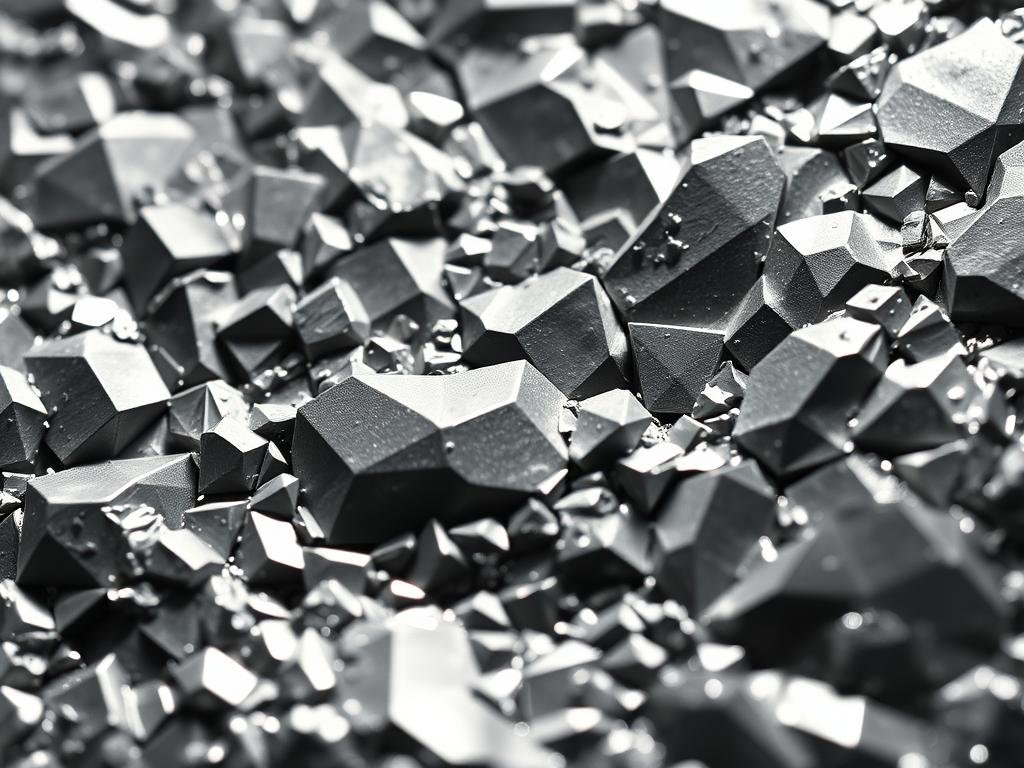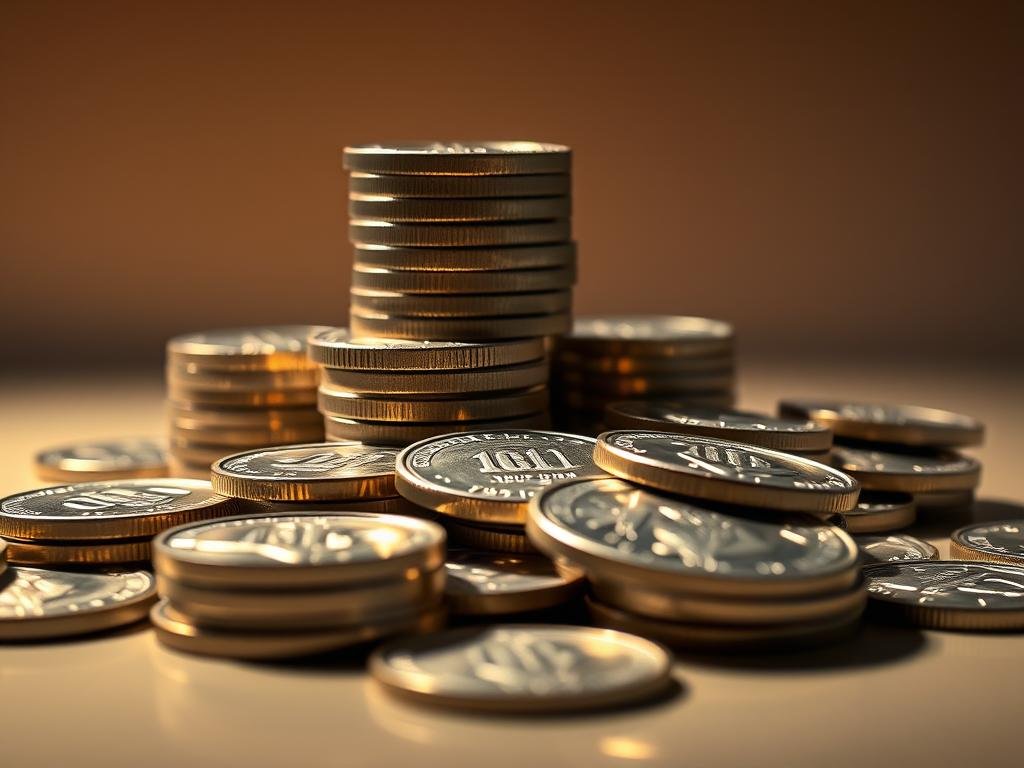銀子是最具多功能性和價值的之一 貴金屬 在世界上,具有其獨特的 密度 在確定其價值和應用方面扮演著關鍵角色。
The 銀的密度 是每立方公分10.49克(g/cm³),相較於銅和鎳等常見金屬較高,但低於金。
了解像銀這樣的貴金屬的物理特性,對投資者、收藏家和工業用戶來說都至關重要。它提供了對金屬的真實性、純度和潛在應用的見解,成為評估其 重量 和 mass.
這份全面指南將探討銀的密度如何影響其市場價值和工業用途,並將其與其他金屬進行比較,並檢視影響其密度的因素。
了解銀的密度
了解銀的密度對於欣賞其價值與真實性至關重要。密度是一個基本的物理性質,能揭示許多關於材料組成與特性的資訊。
What Is Density and How Is It Measured?
Density is defined as mass per unit volume of a substance. It’s typically measured in grams per cubic centimeter (g/cm³). To measure density, one must know the mass and volume of the object.
Silver’s Density: 10.49 Grams per Cubic Centimeter
純銀的密度為每立方公分10.49克。這個數值是銀的原子結構及其面心立方晶格的結果。銀的密度高於常見金屬如銅,但低於黃金。
- Pure silver’s density is precisely 10.49 g/cm³, making it denser than many metals.
- 一個邊長1公分的純銀立方體重恰好10.49克。
- The consistent density of silver provides a reliable benchmark for verifying its authenticity.
Silver Density Compared to Other Metals
了解銀的密度與其他金屬相比較,對投資者和愛好者來說都非常重要。銀的密度是每立方公分10.49克,與其他金屬有顯著的差異。
How Silver Compares to Common Metals
When comparing silver to common metals, its density is higher than aluminum (2.7 g/cm³) and copper (8.96 g/cm³) but lower than lead (11.34 g/cm³). This comparison is essential for understanding the physical properties of silver in various applications.
Silver vs. Other Precious Metals
Among precious metals, silver occupies a middle position in terms of density. Gold has a density of 19.32 g/cm³, and platinum has a density of 21.45 g/cm³, making them significantly denser than silver. On the other hand, palladium, with a density of 12.02 g/cm³, is only slightly denser than silver. The substantial density difference between silver and gold (nearly 2:1) has historically made gold more convenient for high-value transactions in smaller physical packages.
密度差異解釋了為何一盎司的金幣明顯比一盎司的銀幣小,儘管它們含有相同質量的金屬。對投資者來說,了解這些密度關係有助於解釋相同重量但成分不同的貴金屬產品之間的物理差異。
Factors Affecting Silver Density
Understanding the factors that affect silver’s density is crucial for various applications, from industrial manufacturing to investment-grade products.
Temperature Effects on Silver Density
Temperature significantly impacts silver’s density. As temperature increases, silver expands, reducing its density. Conversely, decreasing temperatures cause silver to contract, increasing its density.
Purity and Its Impact on Density
The purity of silver also affects its density. Pure silver has a density of 10.49 g/cm³, but the presence of impurities or alloying elements can alter this value. For instance, sterling silver, which is 92.5% silver, has a slightly different density due to the presence of other metals.
Pressure and Structural Changes
External pressure can significantly affect silver’s density. Under high pressure, the atoms are packed more closely, increasing density. For example, under extreme pressure, silver’s density can increase.
| 因素 | Effect on Density |
|---|---|
| 溫度升高 | Decreases Density |
| Purity | Impacts Density Based on Impurities |
| 壓力增加 | Increases Density |

Silver Alloys and Their Densities
Silver alloys are mixtures of silver with other metals, designed to enhance its properties for various applications. These alloys are crucial in industries where pure silver’s properties need to be modified to suit specific requirements.
Sterling Silver: Composition and Density
Sterling silver, a popular silver alloy, contains 92.5% silver and 7.5% other metals, usually copper. This composition gives sterling silver a density of approximately 10.3 g/cm³, making it more durable than pure silver while retaining much of its desirable properties.
Other Common Silver Alloys
Beyond sterling silver, other alloys exist with varying densities. For instance, coin silver, with 90% silver and 10% copper, has a density of about 10.31 g/cm³. Britannia silver, containing 95.8% silver, has a density closer to pure silver at approximately 10.42 g/cm³. Modern alloys like Argentium silver offer improved tarnish resistance and maintain a similar density to sterling silver.
How Density Determines Silver Authenticity
銀的真實性通常通過其密度來驗證,這是區分真正銀與仿冒品的關鍵因素。密度測試是一個可靠的識別仿冒銀的方法,因為它利用銀與常見仿冒品中所用的基礎金屬之間的密度差異。
銀的密度測試方法
密度測試涉及測量銀器的重量和體積,以計算其密度。這可以使用簡單的工具,如天平和量筒,或更先進的設備,如水壓秤來完成。通過將計算出的密度與已知的銀的密度(10.49 g/cm³)進行比較,可以驗證其真實性。
Identifying Counterfeit Silver Through Density
Counterfeit silver products often use metals like zinc (7.14 g/cm³), tin (7.31 g/cm³), or lead (11.34 g/cm³), which have densities significantly different from that of genuine silver. Even sophisticated counterfeits with a silver coating over a base metal core can be detected through density testing, as the overall density will not match that of solid silver.
| 金屬 | 密度 (g/cm³) |
|---|---|
| 銀 | 10.49 |
| 鋅 | 7.14 |
| 錫 | 7.31 |
| Lead | 11.34 |
By understanding how to perform basic density tests, collectors and investors can protect themselves against counterfeit silver products. The relationship between an object’s weight and volume provides a mathematical signature that’s difficult to falsify without using genuine silver.
Silver Coins and Bullion: Density Considerations
銀幣和金條是受歡迎的投資選擇,其密度是判斷真偽和價值的關鍵因素。銀的密度為每立方公分10.49克,在各種產品中保持一致。
Popular Silver Coins and Their Specifications
Popular silver coins, such as the American Silver Eagle and Canadian Silver Maple Leaf, adhere to strict minting standards, ensuring their density matches that of pure silver. These coins are typically minted with a high purity level, guaranteeing their density is very close to 10.49 grams per cubic centimeter.
- American Silver Eagle: .999 fine silver
- Canadian Silver Maple Leaf: .9999 fine silver
Silver Bars and Investment-Grade Products
銀條,從1盎司到1000盎司不等,保持銀的標準密度。由倫敦金銀市場協會制定的銀條交貨標準,規定最低純度為99.9%銀,確保密度的一致性。像PAMP Suisse和Johnson Matthey這樣的知名冶煉商都保持著精確的密度規範。

利用銀的密度的工業應用
銀的密度在各種工業應用中扮演著關鍵角色,提升多個行業的性能與耐久性。
Electronics and Electrical Components
銀在電子產品中被廣泛使用,因為它具有高導電性和耐用性。在光伏電池中,銀的密度和導電性被用來製造耐用的電接點,能在數十年內保持性能。
- 銀的高導電性使其非常適合用於電子元件。
- 其耐用性確保在嚴苛應用中的長久使用。
再生能源與醫療應用
在可再生能源領域,銀的密度支持太陽能電池的穩定性能。醫療設備也受益於銀獨特的密度、抗菌特性和生物相容性。
- 銀在水質淨化系統中用於其抗菌特性。
- 電池和能源儲存技術採用銀,因其密度和導電性。
銀密度與價值之間的關係
了解銀的密度與其價值之間的關係對投資者來說至關重要。銀的密度為每立方公分10.49克,作為一個基本屬性,可能會對其市場價值產生重大影響。
密度如何影響市場定價
銀的密度影響其市場定價,作為真實性和純度的基準。投資者常依靠密度測量來驗證銀產品的品質,從而影響他們願意為高品質商品支付的溢價。
密度作為投資者的品質指標
對於認真的投資者來說,銀的穩定密度是主要的品質指標。投資級銀產品保持嚴格的密度規範,提供可量化的純度評估,幫助投資者做出明智的決策。
如行業專家所指出的,「產品測量密度與純銀理論密度之間的關係對於驗證其真實性至關重要。」了解這一特性不僅能確保購買的信心,也突顯銀作為有形資產的可靠性。
在家測量銀密度的實用技巧
只需幾個簡單的測量,你就可以判斷你的銀器密度,避免昂貴的錯誤。測量銀的密度涉及計算其重量和體積。
Simple Tools and Techniques
要測量銀的密度,你需要一個精確的秤和一個測量體積的方法,例如水排移法。確保銀器完全濕潤且無氣泡,以獲得準確的結果。
常見錯誤避免
在測量銀的密度時,避免常見的陷阱,例如使用不精確的秤或忽略溫度因素。請注意,複雜的形狀或空心零件可能導致體積測量不準確。此外,不要期望所有銀製品的密度都恰好為10.49 g/cm³,因為像純銀合金(如純銀)可能會有所變化。
- 確保使用精確的秤來測量準確的重量。
- 使用水位移法測量體積,避免氣泡。
- 考慮測量時的溫度。
結論:了解銀密度的重要性
The significance of silver’s density extends far beyond a simple physical property. It is a cornerstone of its value, versatility, and authenticity. With a precise density of 10.49 grams per cubic centimeter, silver’s characteristics make it invaluable in various applications, from coins and jewelry to electronics and renewable energy.
Understanding silver density provides a powerful tool for verifying authenticity and assessing quality. As technology advances, the relationship between silver’s density and its industrial applications continues to evolve, creating new demands for this versatile material. For investors, collectors, and manufacturers, silver’s density remains a constant physical property that grounds its value in measurable reality.
